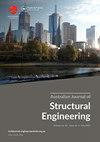Automatic Bayesian modal identification method for structures based on blind source separation
IF 1.3
Q4 ENGINEERING, CIVIL
Australian Journal of Structural Engineering
Pub Date : 2021-09-11
DOI:10.1080/13287982.2021.1970700
引用次数: 0
Abstract
ABSTRACT An automatic Bayesian modal identification method is proposed using the blind source separation (BSS) technique. The determination of resonant frequency bands, which is the initial step of the fast Bayesian FFT (fast Fourier transform) method, requires human intervention and hence, is labour-intensive and subjective. To automate the determination of resonant frequency bands, the BSS technique is introduced here for band selection process. After estimating the modal responses from measured data, the hump criterion curves are drawn to sharpen the border of the resonant humps. And the frequency bands can thus be determined automatically by locating the resonant humps with a peak picking algorithm. The proposed method was validated with a simulated 6- degree-of-freedom spring-mass model, a simulated 4-story benchmark model, the Heritage Court Tower in Vancouver, Canada. The robust identification results indicate that the proposed method can identify automatically and accurately the physical modes together with their uncertainty.基于盲源分离的结构贝叶斯模态自动识别方法
提出了一种基于盲源分离(BSS)技术的贝叶斯模态自动识别方法。谐振频带的确定是快速贝叶斯FFT(快速傅里叶变换)方法的第一步,需要人工干预,因此是劳动密集型和主观的。为了实现共振频带的自动确定,本文引入了BSS技术进行波段选择。在对实测数据进行模态响应估计后,绘制驼峰判据曲线来锐化谐振驼峰的边界。利用挑峰算法对谐振峰进行定位,从而自动确定其频带。以加拿大温哥华Heritage Court Tower的6自由度弹簧-质量模拟模型和4层基准模型为例,对所提方法进行了验证。鲁棒性辨识结果表明,该方法能够自动准确地辨识出物理模式及其不确定性。
本文章由计算机程序翻译,如有差异,请以英文原文为准。
求助全文
约1分钟内获得全文
求助全文
来源期刊

Australian Journal of Structural Engineering
ENGINEERING, CIVIL-
CiteScore
2.50
自引率
0.00%
发文量
31
期刊介绍:
The Australian Journal of Structural Engineering (AJSE) is published under the auspices of the Structural College Board of Engineers Australia. It fulfils part of the Board''s mission for Continuing Professional Development. The journal also offers a means for exchange and interaction of scientific and professional issues and technical developments. The journal is open to members and non-members of Engineers Australia. Original papers on research and development (Technical Papers) and professional matters and achievements (Professional Papers) in all areas relevant to the science, art and practice of structural engineering are considered for possible publication. All papers and technical notes are peer-reviewed. The fundamental criterion for acceptance for publication is the intellectual and professional value of the contribution. Occasionally, papers previously published in essentially the same form elsewhere may be considered for publication. In this case acknowledgement to prior publication must be included in a footnote on page one of the manuscript. These papers are peer-reviewed as new submissions. The length of acceptable contributions typically should not exceed 4,000 to 5,000 word equivalents. Longer manuscripts may be considered at the discretion of the Editor. Technical Notes typically should not exceed about 1,000 word equivalents. Discussions on a Paper or Note published in the AJSE are welcomed. Discussions must address significant matters related to the content of a Paper or Technical Note and may include supplementary and critical comments and questions regarding content.
 求助内容:
求助内容: 应助结果提醒方式:
应助结果提醒方式:


